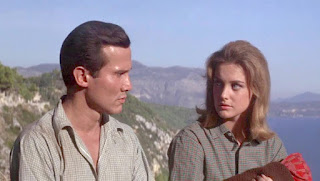Directed by Roger Corman; produced by Gene Corman
In 1943, a British Army major (Stewart Granger) leads five condemned criminals on a secret mission to Axis-occupied Yugoslavia. Each man, promised a pardon in return for his co-operation, has a particular talent that may turn a forlorn hope into a victory for the Allies - if the prisoners don’t kill each other first.
The Secret Invasion may have served as inspiration for the bigger-budgeted and more famous The Dirty Dozen, made three years later. The lesser known item of any pair always invites comparison to its rival, and The Secret Invasion holds up well.
Most familiar with film-study know the name of Roger Corman. Though his movies are almost universally low-budget, they are often well-made with what they had to work with; Corman himself introduced a large number of now-famous names to audiences, and has been a huge influence on many directors and producers, encouraging especially independent film-makers. This movie is typical of his better pictures, making the most of its limited funds and working with a good story.
The location shooting seizes full advantage of the setting. The movie takes place largely in the then-Yugoslav city of Dubrovnik (formerly Ragusa), on the coast of the Adriatic Sea. The solid-looking stone buildings, red-tile roofs and formidable forts of the ancient town were put to good use. In particular, there is a roof-top gun-battle that must have taken some convincing of municipal authorities; the results are exciting.
The cast is good as well, though not first-class. One certainly can’t expect such a diversity in actors in many other movies. International-film star Raf Vollone, Edd Byrnes (best known as ‘Kookie’ from 77 Sunset Strip), perennial villain Henry Silva, Mickey Rooney (by this time, passing from his second phase of Hollywood stardom) and character player William Campbell, all seem to be of different acting types and from different genres of cinema, and so lend an authenticity to the motley make-up of the criminal team. The performances are varied but capable.
The story is more complicated than many action-flicks boast. Italy has just surrendered to the Allies, and the Germans are ready to seize Italian positions and personnel if the latter switch allegiance from Fascism to the Allies. The major and his men must rescue an Italian general, in German custody, whose pronouncement in favour of the Allies could bring thousands of Italian troops into the war against the Nazis. But there is deception to be found both at the team’s destination and even in their own numbers.
The script is the weakest element of the movie. The individuals of the mission come together too easily, too soon, and the major leading them comes to trust them too soon as well, for credibility. Some members are more believable than others: Vallone’s criminal mastermind seems to be anti-Fascist to begin with, and Silva’s assassin-for-hire probably sees the mission as no more than another job. But motivation is lacking.
By and large, however, The Secret Invasion is a good, entertaining adventure movie, with more than one twist in its plot.








































